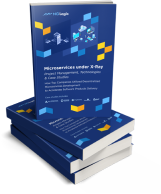Rust and Python are two highly recognizable names among modern developers. Python, the older of the two programming languages, has been enjoying a stable and dominant position for the past few years. Moreover, it is considered one of the easier languages to pick as a beginner making it one of the most popular programming languages among younger developers.
On the other hand, Rust is a younger programming language that focuses on high performance and code safety. In that aspect, you could treat it like a C or C++ that is also preventing memory leaks. Rust easily deals with processing large amounts of data and has a very effective compiler. No wonder it’s currently one of the most popular languages among developers worldwide.
Both Rust and Python are solid programming languages and it might be hard to pick one over the other. Today, however, we’ll talk a bit about the characteristics and business usage of both technologies and how they fare against each other.
Python, a Swiss army knife among other programming languages
Python is an object-oriented, general-purpose programming language with dynamic semantics. It is an interpreted language which means that the Python source code is converted into bytecode. A Python virtual machine then executes that bytecode.
Python also has a high level of built-in data structures. Throw dynamic typing and binding in and you have an excellent programming language for scripting or gluing different components together into a working app.
Python is also a multiparadigm programming language, which means that it supports different manners of writing Python code, like the aforementioned object-oriented, but also functional, imperative, or procedural.
Moreover, Python is very easy to learn. Simple syntax with good readability, a huge number of Python libraries, frameworks, and well-maintained Python documentation make it a great choice for a first language to learn web application development.
Why developers love Python
Python is the main weapon of choice for many developers and businesses alike for a number of reasons, beginner-friendliness being just one of them. It’s 30 years old now, which means that besides hurting lower back it has a sprawling and mature community that is willing to support everyone no matter the level they are at.
Support from the big tech
Moreover, a number of corporate entities, such as Google, Facebook, and Amazon, also support Python development and usage. Add good documentation, the facts it is open-source, and a ton of tested and tried resources and you have a very solid environment for developing both individual skills and the company tech stack.
Flexibility
When it comes to more technical reasons, software developers tend to enjoy Python’s flexibility. One of the things that kill the drive is doing the same thing over and over again. As Python does not restrict the developers to any one environment or application it allows them to work with the same tool on a different set of problems.
Automation
Additionally, Python is a language that supports a lot of automation both in development and code testing. Another caveat is that because it is an interpreted language it does not need pre-runtime compilation. This makes developing in Python that much faster.
Python and Machine Learning
Although Python is a general-purpose language, the fields in which it enjoys considerable popularity are Machine Learning, Data Science, and Cloud Computing. A lot of data science and analysis tools are powered by Python and its strong collection of machine learning libraries such as Pandas, PyTorch, Scipy, Theano, and TensorFlow to name just a few.
Highly readable code structure
Python’s syntax is perhaps the most well-known across all of system programming, and its code structure is highly readable, making it pretty simple to learn, understand, and troubleshoot. This really helps Python shine.
An active community
Being one of the most popular programming languages out there, Python has a large community of helpful programmers who are sure to make your Python journey a bit easier.
Python’s disadvantages
Python might seem like a perfect language, but, just like anything in software development, it has its downsides. Going past the personal preferences and subjective opinions of software developers, the two most common disadvantages pointed out by the users are speed and error handling.
Being an interpreted language, Python sometimes can be slower than Java, C++, or other compiled languages. On the topic of error handling, though debugging in Python is generally very smooth, in a big way thanks to a wide choice of libraries and Python tooling integrated into the IDEs, some errors won’t be detected until runtime. This, in turn, slows down the testing and maintenance process. The way Python manages memory is a bit different than Rust, as Python uses garbage collection to handle memory. This method of garbage collection can impact performance.
Rust, a general-purpose programming language focused on safety
Rust is a statically typed programming language with a particular focus on memory management and code safety. It was designed by Mozilla Research software developer Graydon Hoare, who was also responsible for creating Swift language. Syntactically, Rust is similar to C++.
Even though Rust is a much younger language than Python, it has become very popular within a relatively short time. According to a developer survey conducted by StackOverflow in 2021, it is in fact the most-liked technology on the market. Why? Rust has some particular advantages compared to other languages.
Memory safety and performance-oriented programming
Rust design screams good performance. It is generally much quicker and more efficient than other languages. It has a great memory architecture that is safe from memory leaks (of course not all, but most) and has no runtime or garbage collector. Without a need for a garbage collector running around the clock, Rust projects can be comfortably used by other languages as libraries. That way you can use Rust’s quick and memory-safe code for performance-critical pieces of your project. Another big thing with Rust is that it enforces strict memory allocations and is hell-bent on secure coding practices.
Low-level language
Rust is a low-level language. In short, that means a Rust engineer will operate “much closer” to the machine and the operating systems. Like any other low-level language (C/C++), Rust gives direct and safe control over low-level resources.
With Rust, you can either store data on the stack or on the heap. Rust also determines at the compile time freeing the memory right when it is no longer needed. This allows using memory efficiently and more performant memory access, with some users reporting a reduction in memory usage from 5GiB to 50 MiB by switching from Java to Rust.
Rust’s disadvantages
First and foremost, writing in Rust takes time. You won’t be able to write working code as fast as with other scripting languages such as Python. Moreover, many developers report finding Rust uncomfortable or weird.
Moreover, Rust is fresh. Although you do have good official documentation run by Rust developers, the number of additional resources is relatively small. Additionally, Rust code is generally rather complex and harder to learn which requires a lot of general coding knowledge from the end user to be able to master Rust.
Rust vs Python and their usage
Both Python and Rust are amazing and quite versatile tools, however, they do better at different roles and when used for different purposes.
Python: machine learning and artificial intelligence
Python is an amazing choice for machine learning and artificial intelligence projects. ML and AI projects often have very specific requirements and needs. Python has a stable base and a number of dedicated tools, frameworks, and libraries (some specifically made with ML in mind) which makes it often chosen over other languages.
Python: web systems programming
Another excellent usage for Python is web development. Frameworks such as Django or Flask turn Python into a tool specialized for web applications. Here you have content management, easy maintenance, database access, and data authorization functions. Add a simple syntax and a ton of resources to the mix and you can develop new web applications very quickly.
Python: data analysis
Last but not least, Python is one of the go-to languages for data visualization and analysis. You can quite easily separate data for better analysis. You also have a lot of libraries that help with writing the code. With a relatively smaller learning curve, it is a very popular choice among data scientists who have to fill many boots at once.
Rust: Microcontrollers and operating systems
Rust is a solid choice for any project deeply involved with microcontroller applications or operating systems programming. Because of its low-level features and characteristics, you have fewer intermediary systems between your code snippet and the hardware.
Rust: Embedded systems
This is yet another use example where direct access to hardware and memory management matters.
Rust comes equipped with a whole range of features particularly useful for embedded systems programming such as powerful system analysis, strict safe memory allocations, and dynamic data structures. Rust also makes it impossible to share state between threads by accident and supports interoperability and portability. Moreover, as a part of the Rust open-source programming language project, support for this branch is driven by experts in the field.
Rust: replacement for other programming languages
It is possible (and quite popular) to rewrite only parts of the product. You would usually choose those parts that require better performance or need to have better memory safety.
Python and Rust: Which is better?
It depends. Really.
There are a lot of different factors to take into consideration. Even then, the conclusions would differ depending on the context.
If we focus on performance, Rust is definitely the faster one of the two, but high speed was never one of Python’s intended strong points. On the other hand, Rust was built with speed in mind. Rust’s code compiler translates the input directly into machine code. In Python’s case, a Python interpreter is needed to run the code.
When it comes to code security, however, the answer is not that simple. Both languages prove to be quite secure codewise. Python automatically prevents any memory leaks. You can also configure custom memory management. Rust was designed with secure memory management in mind. It is memory-safe unless the developer decides otherwise, so you generally have two coding modes. One is completely memory-safe Rust, the other is Safe
What about error handling? Python flags expectations. Rust returns a value and gives some clues on how to fix the issue, which makes it easier to debug. So Rust is better with error handling? Well, not exactly. Rust, as a relatively new language, lacks the big community and tooling that Python has. Many IDEs for Python considerably improve Python debugging through plugins.
Last but not least, which is easier to pick up? Python is known as one of the best and easiest languages to learn and is often recommended to new programmers just starting to learn the craft. Rust has a considerably higher learning curve compared to Python, mostly due to its low-level language characteristics and more complex coding requirements and syntax.













 +1 (888)
413 3806
+1 (888)
413 3806